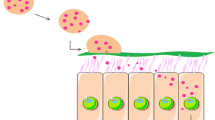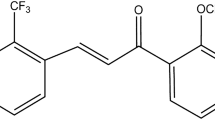Abstract
Purpose
Pulmonary delivery of biologics is of great interest, as it can be used for the local treatment of respiratory diseases or as a route to systemic drug delivery. To reach the full potential of inhaled biologics, a formulation platform capable of producing high performance aerosols without altering protein native structure is required.
Methods
A formulation strategy using Particle Replication in Non-wetting Templates (PRINT) was developed to produce protein dry powders with precisely engineered particle morphology. Stability of the incorporated proteins was characterized and the aerosol properties of the protein dry powders was evaluated in vitro with an Andersen Cascade Impactor (ACI).
Results
Model proteins bovine serum albumin (BSA) and lysozyme were micromolded into 1 μm cylinders composed of more than 80% protein, by mass. Extensive characterization of the incorporated proteins found no evidence of alteration of native structures. The BSA formulation produced a mass median aerodynamic diameter (MMAD) of 1.77 μm ± 0.06 and a geometric standard deviation (GSD) of 1.51 ± 0.06 while the lysozyme formulation had an MMAD of 1.83 μm ± 0.12 and a GSD of 1.44 ± 0.03.
Conclusion
Protein dry powders manufactured with PRINT could enable high-performance delivery of protein therapeutics to the lungs.








Similar content being viewed by others
Abbreviations
- ACI:
-
Andersen cascade impactor
- BSA:
-
Bovine serum albumin
- CD:
-
Circular dichroism
- DPI:
-
Dry powder inhaler
- ED:
-
Emitted dose
- ELSD:
-
Evaporative light scattering detector
- FDKP:
-
Fumaryl diketopiperazine
- FPF:
-
Fine particle fraction
- GSD:
-
Geometric standard deviation
- HDODA:
-
Hexanediol diacrylate
- HPMC:
-
Hydroxypropyl methylcellulose
- MDI:
-
Metered dose inhaler
- MMAD:
-
Mass median aerodynamic diameter
- PEG:
-
Polyethylene glycol
- PET:
-
Poly(ethylene terephthalate)
- PPS:
-
Pre-particle solution
- PRINT:
-
Particle replication in non-wetting templates
- PVPVA:
-
Poly(1-vinylpyrrolidone-co-vinyl acetate)
- SD:
-
Spray drying
- SFD:
-
Spray freeze drying
References
Bäckman P, Adelmann H, Petersson G, Jones CB. Advances in inhaled technologies: understanding the therapeutic challenge, predicting clinical performance, and designing the optimal inhaled product. Clin Pharmacol Ther. 2014;95(5):509–20.
Hoe S, Boraey MA, Ivey JW, Finlay WH, Vehring R. Manufacturing and device options for the delivery of biotherapeutics. J Aerosol Med Pulm Drug Deliv. 2014;27:1–14.
Weers JG, Miller DP. Formulation design of dry Powders for inhalation. J Pharm Sci. 2015;104(10):3259–88.
Claus S, Weiler C, Schiewe J, Friess W. How can we bring high drug doses to the lung? Eur J Pharm Biopharm. 2014;86(1):1–6.
Patton JS. Mechanisms of macromolecule absorption by the lungs. Adv Drug Deliv Rev. 1996;19(1):3–36.
Patton JS. The lungs as a portal of entry for systemic drug delivery. Proc Am Thorac Soc. 2004;1(4):338–44.
Labiris NR, Dolovich MB. Pulmonary drug delivery. Part II: the role of inhalant delivery devices and drug formulations in therapeutic effectiveness of aerosolized medications. Br J Clin Pharmacol. 2003;56(6):600–12.
Maltesen MJ, van de Weert M. Drying methods for protein pharmaceuticals. Drug Discov Today Technol. 2008;5(2–3):e81–8.
Longest PW, Tian G, Li X, Son YJ, Hindle M. Performance of combination drug and hygroscopic excipient submicrometer particles from a Softmist inhaler in a characteristic model of the airways. Ann Biomed Eng. 2012;40(12):1–15.
Borgström L, Olsson B, Thorsson L. Degree of throat deposition can explain the variability in lung deposition of inhaled drugs. J Aerosol Med. 2006;19(4):473–83.
de Boer AH, Hagedoorn P, Hoppentocht M, Buttini F, Grasmeijer F, Frijlink HW. Dry powder inhalation: past, present and future. Expert Opin Drug Deliv. 2017;14(4):499–512.
Chow AHL, Tong HHY, Chattopadhyay P, Shekunov BY. Particle engineering for pulmonary drug delivery. Pharm Res. 2007;24(3):411–37.
Vehring R. Pharmaceutical particle engineering via spray drying. Pharm Res. 2008;25(5):999–1022.
Dolovich MB, Dhand R. Aerosol drug delivery: developments in device design and clinical use. Lancet. 2011;377(9770):1032–45.
Bekard IB, Asimakis P, Bertolini J, Dunstan DE. The effects of shear flow on protein structure and function. Biopolymers. 2011;95(11):733–45.
Winters MA, Knutson BL, Debenedetti PG, Sparks HG, Przybycien TM, Stevenson CL, et al. Precipitation of proteins in supercritical carbon dioxide. J Pharm Sci. 1996;85(6):586–94.
Potocka E, Cassidy JP, Haworth P, Heuman D, van Marle S, Baughman RA. Pharmacokinetic characterization of the novel pulmonary delivery excipient fumaryl diketopiperazine. J Diabetes Sci Technol. 2010;4(5):1164–73.
Cassidy JP, Amin N, Marino M, Gotfried M, Meyer T, Sommerer K, et al. Insulin lung deposition and clearance following technosphere ® insulin inhalation powder administration. Pharm Res. 2011;28(9):2157–64.
Bromberg L, Rashba-Step J, Scott T. Insulin particle formation in supersaturated aqueous solutions of poly(ethylene glycol). Biophys J. 2005;89(5):3424–33.
Garcia A, Mack P, Williams S, Fromen C, Shen T, Tully J, et al. Microfabricated engineered particle Systems for Respiratory Drug Delivery and Other Pharmaceutical Applications. J Drug Deliv. 2012;2012:1–10.
Mack P, Horvath K, Tully J, Maynor B. Particle engineering for inhalation formulation and delivery of biotherapeutics. Inhalation. 2012;6:16–20.
Fromen CA, Shen TW, Larus AE, Mack P, Maynor BW, Luft JC, et al. Synthesis and characterization of monodisperse uniformly shaped respirable aerosols. AICHE J. 2013;59(9):3184–94.
Rahhal TB, Fromen CA, Wilson EM, Kai MP, Shen TW, Luft JC, et al. Pulmonary delivery of Butyrylcholinesterase as a model protein to the lung. Mol Pharm. 2016;13(5):1626–35.
Khodabandehlou K, Kumbhar AS, Habibi S, Pandya AA, Luft JC, Khan SA, et al. Silylated precision particles for controlled release of proteins. ACS Appl Mater Interfaces. 2015;7(10):5756–67.
Xu J, Wang J, Luft JC, Tian S, Owens G, Pandya AA, et al. Rendering protein-based particles transiently insoluble for therapeutic applications. J Am Chem Soc. 2012 [cited 2014 Jul 9];134(21):8774–7.
Bantan-Polak T, Kassai M, Grant KB. A comparison of Fluorescamine and Naphthalene-2,3-dicarboxaldehyde Fluorogenic reagents for microplate-based detection of amino acids. Anal Biochem. 2001;297(2):128–36.
Ameri M, Maa Y-F. Spray drying of biopharmaceuticals: stability and process considerations. Dry Technol. 2006;24(6):763–8.
Chan HK. Dry powder aerosol drug delivery-opportunities for colloid and surface scientists. Colloids Surf A Physicochem Eng Asp. 2006;284–285:50–5.
Frokjaer S, Otzen DE. Protein drug stability: a formulation challenge. Nat Rev Drug Discov. 2005;4(4):298–306.
Mumenthaler M, Hsu CC, Pearlman R. Feasibility study on spray-drying protein pharmaceuticals: recombinant human growth hormone and tissue-type plasminogen activator [internet]. Pharm Res. 1994;11:12–20.
Costantino HR, Firouzabadian L, Hogeland K, Wu C, Beganski C, Carrasquillo KG, et al. Protein spray-freeze drying. Effect of atomization conditions on particle size and stability. Pharm Res. 2000;17(11):1374–83.
Shoyele SA, Sivadas N, Cryan S. The effects of excipients and particle engineering on the biophysical stability and aerosol performance of parathyroid hormone (1-34) prepared as a dry powder for inhalation. AAPS PharmSciTech. 2011;12(1):304–11.
Hulse WL, Forbes RT, Bonner MC, Getrost M. Do co-spray dried excipients offer better lysozyme stabilisation than single excipients? Eur J Pharm Sci. 2008;33(3):294–305.
Yu Z, Johnston KP, Williams RO. Spray freezing into liquid versus spray-freeze drying: influence of atomization on protein aggregation and biological activity. Eur J Pharm Sci. 2006;27(1):9–18.
Capelle MAH, Gurny R, Arvinte T. High throughput screening of protein formulation stability: practical considerations. Eur J Pharm Biopharm. 2007;65(2):131–48.
Garidel P, Hegyi M, Bassarab S, Weichel M. A rapid, sensitive and economical assessment of monoclonal antibody conformational stability by intrinsic tryptophan fluorescence spectroscopy. Biotechnol J. 2008;3(9–10):1201–11.
Liao YH, Brown MB, Nazir T, Quader A, Martin GP. Effects of sucrose and trehalose on the preservation of the native structure of spray-dried lysozyme. Pharm Res. 2002;19(12):1847–53.
Xi J, Longest PW. Effects of oral airway geometry characteristics on the diffusional deposition of inhaled nanoparticles. J Biomech Eng. 2008;130(February):11008-1-011008–16.
Behara SRB, Farkas DR, Hindle M, Longest PW. Development of a high efficiency dry powder inhaler: effects of capsule chamber design and inhaler surface modifications. Pharm Res. 2014;31(2):360–72.
Telko MJ, Hickey AJ. Dry powder inhaler formulation. Respir Care. 2005;50(9):1209–27.
Crowder TM, Rosati JA, Schroeter JD, Hickey AJ, Martonen TB. Fundamental effects of particle morphology on lung delivery: predictions of stokes’ law and the particular relevance to dry powder inhaler formulation and development. Pharm Res. 2002;19(3):239–45.
Mitchell JP, Nagel MW. Cascade impactors for the size characterization of aerosols from medical inhalers: their uses and limitations. J Aerosol Med. 2003;16(4):341–77.
Finlay WH, Gehmlich MG. Inertial sizing of aerosol inhaled from two dry powder inhalers with realistic breath patterns versus constant flow rates. Int J Pharm. 2000;210(1–2):83–95.
Bosquillon C, Lombry C, Préat V, Vanbever R. Influence of formulation excipients and physical characteristics of inhalation dry powders on their aerosolization performance. J Control Release. 2001;70(3):329–39.
Shur J, Saluja B, Lee S, Tibbatts J, Price R. Effect of device design and formulation on the in vitro comparability for multi-unit dose dry powder inhalers. AAPS J. 2015;17(5):1105–16.
Cicerone MT, Pikal MJ, Qian KK. Stabilization of proteins in solid form. Adv Drug Deliv Rev. 2015;93:14–24.
Pilcer G, Amighi K. Formulation strategy and use of excipients in pulmonary drug delivery. Int J Pharm. 2010;392(1–2):1–19.
Acknowledgments and Disclosures
We thank C. Caudill, T. Rahhal, A. Johnson, J. Perry, J. Coffman, C. Bloomquist, and S. Tian for helpful discussions and technical assistance. We acknowledge Liquidia Technologies for providing PRINT molds. We acknowledge core facilities at UNC, including the Chapel Hill Analytical and Nanofabrication Laboratory (CHANL) which is supported by the National Science Foundation (ECCS-1542015) and the Macromolecular Interactions Facility which is supported by the National Institutes of Health (P30CA016086). This work was funded by the DTRA award (HDTRA1–13–1-0045). J.M.D. is a founder and maintains a financial interest in Liquidia Technologies.
Author information
Authors and Affiliations
Corresponding author
Rights and permissions
About this article
Cite this article
Wilson, E.M., Luft, J.C. & DeSimone, J.M. Formulation of High-Performance Dry Powder Aerosols for Pulmonary Protein Delivery. Pharm Res 35, 195 (2018). https://doi.org/10.1007/s11095-018-2452-z
Received:
Accepted:
Published:
DOI: https://doi.org/10.1007/s11095-018-2452-z




